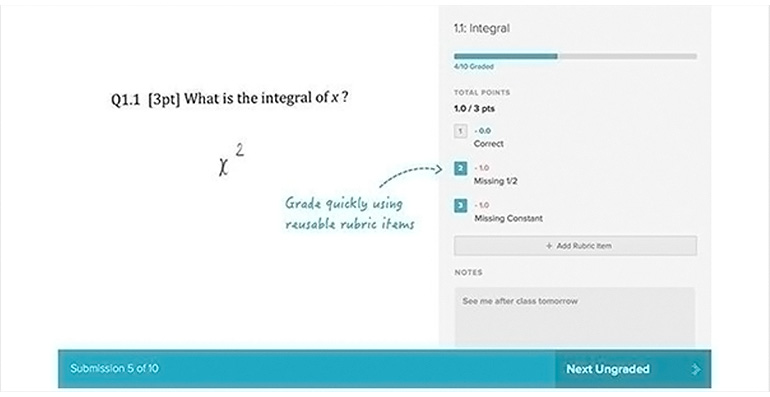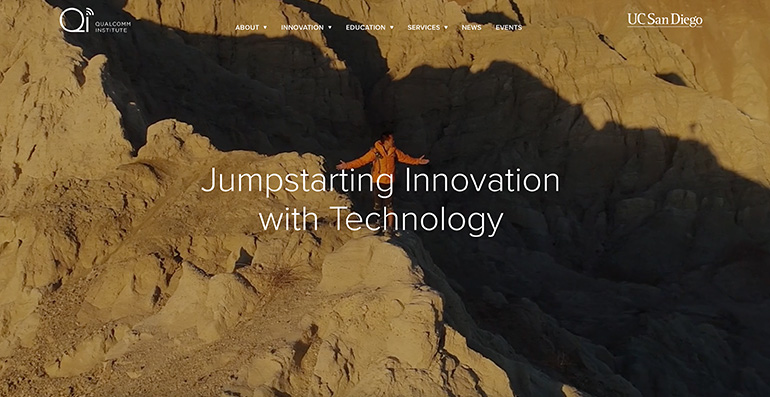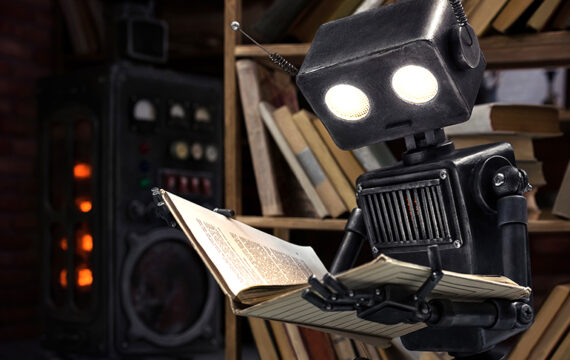Machine learning in education is a prime example of how technology strengthens human processes, especially when it comes to teaching and learning. Whatever your desired outcomes are, from creating educational software to reducing the burden of administrative tasks, machine learning is a vital tool in achieving your goals.
At Intellias, our experts work with clients all over the world to develop technological solutions for the education sector. From language-learning apps to virtual teaching assistant chatbots, Intellias engineers work on effective solutions that transform the learning process. We offer powerful tools to make education more engaging, immersive, and accessible.
Bring your ideas to life and improve your students’ learning outcomes with a team of experts by your side.
The role of machine learning in education

Source: SoloWay
Artificial intelligence (AI) and machine learning (ML) is a field of computing that enables algorithms to learn without continual reprogramming or any other external input. By analyzing new data, a system using machine learning becomes more intelligent thanks to its ability to notice and classify patterns and trends. Ultimately, this results in improved performance over time.
The global size of the machine learning for education market size was valued at USD 1.82 billion in 2021 and is forecasted to rise at a compound annual growth rate (CAGR) of 36.0% from 2022 to 2030. Implementing machine learning in education helps students, teachers, and administrators improve their processes and enhance the learning journey.
Identifying learning difficulties
Machine learning uses adaptive learning to identify difficulties students may be experiencing. Due to heavy workloads or overcrowded classrooms, tutors often fail to distinguish struggling students from uninterested participants. Machine learning can help to flag learning issues and enable a tutor or program to alter teaching methods in response.
Personalizing teaching and learning processes
ML algorithms allow educational software to personalize content, schedules, and learning goals to students’ needs and capabilities, thereby improving the efficiency and quality of teaching and learning. This lets tutors shift their focus to processes that benefit from a human perspective.
Predictive analytics
Educators use ML to predict future learning outcomes and change teaching methods based on these outcomes. Predictive analytics detects patterns in student behavior and determines the probability of each student passing a course or pursuing extracurricular activities.
Identifying and predicting problems in K12 education
Machine learning is particularly beneficial at the K12 level. With ML, behavioral problems and poor academic performance can be identified or predicted with a high degree of accuracy. Educators can then intervene and address issues before it’s too late. ML is also used to improve security and to enable students and parents to access self-service tools.
Covering applications in higher education
ML can predict enrollment levels and help higher education institutions find potential applicants. There are also applications for research, as machine learning algorithms can quickly and accurately analyze large, growing datasets.
Improving marketing for EdTech companies
It isn’t just schools and colleges that can benefit from machine learning. Learning and EdTech companies also use ML to improve learning outcomes, customer service, and targeted marketing. Capabilities such as text-to-speech, translation, transcription, chatbots, and content classification are a bonus.
8 key benefits of machine learning in education

Using machine learning in the education sector improves teaching and learning processes in various ways. Experts predict that ML will become an increasingly significant part of the education sector over the coming years due to the many benefits of machine learning applications in education, such as:
Greater global access to online learning
eLearning courses and individual materials (video lectures, eBooks, discussion forums, etc.) can be expensive to translate into different languages. ML programs can use natural language processing and deep learning in education to translate and transcribe content quickly, accurately, and cost-effectively.
More efficient courses
Predictive analytics allows a course to adjust to individual needs. Using machine learning, skills gaps can be identified, and specific pieces of content can be delivered to learners based on their performance. Learners can also see other metrics, including how long they spend on each section and their degree of interaction with course materials. This ensures that ML-based courses are more efficient and effective than traditional one-size-fits-all courses.
Reduced administrative workload
ML-based eLearning courses can automatically carry out many administrative and management tasks including onboarding, scheduling, providing instructions, tracking attendance, and grading work. This frees up time for educators to spend on more creative, subjective, and human-focused tasks.
Personalized learning pathways
One limitation of traditional teaching processes is the homogenous nature of educational courses. Learning styles vary, and homogenous approaches give certain styles an advantage while placing others at a disadvantage. Machine learning systems enable differentiated instruction, where teaching is optimized to suit each individual learner. This allows educators to provide targeted, personalized learning pathways without the extra workload needed to do it manually.
A more effective user experience
Using ML in education can improve the experiences of all eLearning system users, including teachers, learners, and administrators. Personalization of course content and the streamlining of administrative tasks increases engagement and motivation, leading to improved learning outcomes. Self-service capabilities can also be useful for students who lack the confidence to approach teachers or other staff with concerns.
More accurate assessment and grading
While manual grading can be affected by human error and bias, machine learning systems don’t have these limitations. This results in fairer and more accurate grading and assessments. ML algorithms also automatically detect plagiarism in learners’ projects.
Faster research
Machine learning dramatically benefits higher education research departments. Deep data science capabilities (for example, text mining) of ML systems have many implications for the discovery and management of research depositories.
Improved enrolment processes
ML is used extensively in advertising and marketing to identify and reach target audiences. Educational institutions use these capabilities to attract the most suitable students. Each system can also detect and prevent fraud or security concerns during enrolment.
Applications of machine learning in education
Educators seek technology-powered approaches to teaching and learning that would be effective and scalable. Teachers capture the potential of emerging tech to make studying more engaging, immersive, and fun. The uses of machine learning in education, including adaptive learning, inclusive learning, and AI assistants, ensure the development of accessible learning tools and environments.
Adaptive learning
Adaptive learning is a teaching approach that aims to personalize study plans, lessons, assessments, and practice activities applicable for elementary classrooms and high schools. The name speaks for itself, meaning that the learning process will be adjusted for individual students according to their skills, performance, and learning pace.

Source: Adaptive Learning 101: An Ultimate Guide for Educators and Learners
ML algorithms analyze data to tailor educational content, delivering personalized pathways and ensuring students encounter material that is optimally challenging. Moreover, adaptive learning systems provide educators with detailed insights into each student’s learning journey, highlighting strengths, weaknesses, and progress. This data-driven perspective enables teachers to fine-tune their instructional strategies and offer specific support where it’s needed, enhancing the overall quality of education.
Inclusive learning

Inclusive learning customizes experiences for each student’s unique needs, ensuring equitable access to educational opportunities and resources. Backed by machine learning in schools, the approach can provide personalized learning experiences to accommodate various abilities, learning styles, and backgrounds. Through detailed analysis of individual performance and engagement, ML algorithms tailor content in terms of difficulty and format.
Such an adaptability ensures that education is accessible to students with disabilities, special educational needs, and those from different linguistic and cultural backgrounds. Inclusive learning paves the way for a more equitable educational landscape.
Machine learning also offers tools for language translation and content localization, enhancing language and cultural inclusivity within the learning environment. By providing educators with data-driven insights, ML supports the development of inclusive teaching practices and policies.
AI tutors and chatbots
Chatbots and robots are revolutionizing education by making learning more accessible around the clock. Used in both high schools and universities, AI tutors offer personalized content and exercises, available 24/7, to enhance students’ learning experiences. They provide instant feedback on assignments and quizzes, helping students quickly identify and correct their mistakes. Moreover, as scalable solutions, they can support a large number of students simultaneously, alleviating the burden on teachers by handling many of the learners’ questions and queries. This allows teachers to focus more on personalized instruction and managing overcrowded classrooms.
Chatbots cater to students with special educational needs by offering customized learning paths. The data collected by AI systems on students’ learning behaviors offers insights that can inform more effective teaching strategies and help students refine their learning approaches.
Intellias applied machine learning to build a conversational virtual learning assistant for one of our clients. In this case, students with special educational needs were our client’s sales representatives. Our chatbot helped them improve their product knowledge with engaging and personalized training. Powered by artificial intelligence and machine learning, the chatbot makes corporate learning highly interactive and contains easily digestible information.
Task automation
McKinsey predicts that ML-driven education will help teachers ease operational and administrative burden, focusing on students. Having approximately 50 working hours a week, teachers spend less than half the time in direct interaction with students.
Machine learning can help educators reallocate up to 30% of their time toward activities with students, like coaching and direct engagement for better motivation and social skill development. Technology can help teachers come up with better lesson plans and strategies as well as deal with study assessments faster.

Source: McKinsey
Real-world examples of machine learning in education
There are many machine learning use cases in education. Well-known examples include:
UC Berkeley’s Gradescope
At UC Berkeley, a tool called Gradescope streamlines grading workflows during times of high demand. Teachers determine a list of criteria against which the tool compares students’ work to provide accurate performance assessments.

Source: Gradescope screenshot
University of Michigan’s M-Write
The University of Michigan’s M-Write automated text analysis tool was developed using ML principles. It analyzes written assignments to determine which students may need help and aids them with drafting and revising.
UC San Diego’s adaptive tutoring platform
UC San Diego’s online bioinformatics course uses an intelligent tutoring system (ITS) to continually analyze students’ learning paths. Using data to alter course content for each student, it provides actionable data on learner performance to instructors and tutors at regular stages.

Grammarly
The grammar checking and plagiarism detection tool Grammarly has more than 30 million daily users, including teachers and students. The platform is based on machine learning, deep learning, and natural language processing algorithms. Using global data to improve suggestions, it becomes familiar with each user’s writing style and identifies common errors.

Alphary
Intellias developed a natural language processing (NLP) solution to improve the language learning process by applying artificial intelligence and machine learning for semantic analysis and automated feedback. Alphary’s ambitious goal to redefine the English language learning experience turned into an engaging app that increases learners’ engagement with gamification and personalized experiences.
Combining other technologies in education with ML
And what if teachers combine machine learning with other technologies to enhance the education process? They should get an excellent result!
By thoughtfully integrating ML with augmented reality (AR) and virtual reality (VR), robotics, Internet of Things (IoT), data analytics, and even blockchain, educators can create an effective learning experience. The powerful combo of today’s technologies can transform education into a more engaging and personalized process that meets the diverse needs of students. One should remember, though, to approach integration with a focus on enhancing educational outcomes and considering the ethical implications, particularly regarding data privacy and security.
Augmented and virtual reality
Educators can combine AR/VR with machine learning for students on subjects like art, literature, geography, and biology, for example. The constantly evolving virtual reality sector has tremendous potential to improve learning processes by offering access to virtual environments and immersive content. ML, in its turn, can customize this content based on the learner’s progress and interactions, enhancing engagement.
Internet of Things
First of all, teachers can use IoT devices in conjunction with ML to collect data on student engagement. Another variant is to define and track environmental factors that might affect learning, such as classroom temperature or time of day. This data can then be used to optimize the learning conditions and schedule.
Data analytics
Data analytics and dashboard tools powered by ML can provide teachers and students with insights into learning patterns and progress. Students will easily define areas needing improvement, and educators will make more informed decisions about teaching strategies and study plans. At Intellias, we developed a cloud platform for council workers with user-generated content, licensing modules, and authoring tools. The data-powered system improves and personalizes the experience with seminars and courses for its end users.
Gamification
Teachers can employ ML algorithms to personalize gaming elements in educational content, adjusting challenges and rewards to match the student’s learning progress. The ML-powered gamification process can increase motivation and engagement by providing a more tailored learning experience.
Blockchain
By integrating blockchain technology with machine learning, one can achieve secure and transparent record-keeping of students’ achievements and progress. This approach can facilitate personalized learning experiences and reduce the operational and administrative burden on teacher workloads by ensuring accurate data management across various platforms and applications.
Robotics
Robots can be teaching assistants, tutors, or even students’ buddies that help them make learning more fun and effective. By interacting with learners in a friendly way, robots can make processes more personalized and alleviate the routine workloads of teachers. Although robots are getting better at helping in education, they are not replacing teachers but adding a new way to make learning engaging.
Challenges of using machine learning in education
Of course, no technology provides a magic solution for every challenge. While machine learning and education are well-suited, implementing ML at its full potential requires knowledge, planning, and practice. Using ML systems carelessly introduces a new set of challenges and issues.
For example, AI-based technologies can only be as accurate as the data they are provided and trained with. This is why rigid data governance policies are vital. ML programs use instance-based learning, where data is compared to instances experienced during training. As a result, algorithms can replicate human biases (for example, around race, gender, age, or other characteristics). If a system is trained using biased data, these biases can be embedded into the system’s programming and decision-making.
Issues such as biases or inaccuracies can go unnoticed if ML models aren’t regularly audited by those with an understanding of how they learn and work. Simply delegating all tasks, processes, and decisions to education software (for example, an automated grading system) without any human input can be disastrous. Machine learning programs should be treated as useful assistants rather than replacements for human educators and other experts.
The future of machine learning in the education sector
Online learning has already shaken up the education sector and removed many challenges of traditional classroom-based learning. Machine learning is the next step in the evolution of educational technology and is designed to improve teaching and learning even further.
The report by Verified Market Research indicates ML as a promising technology for the education market. The study shows that machine learning, deep learning, and NLP were valued at $1.1 billion globally in 2020 and are projected to grow by $21.52 billion by 2028.
Recent studies predict a significant expansion of the AI/ML technology in education, projecting an increase from $1.10 billion in 2021 to $21.52 billion by 2028. Microsoft also highlights that an overwhelming 99.4% of educators surveyed see the technology as providing a competitive advantage for their institutions in the near future, with 15% viewing AI and machine learning in education as a transformative force.

Source: MarketResearch.biz
Predictive data and analytics enable more personalized, customized, and streamlined learning pathways while increasing learner engagement. As a result, educators’ focus will shift from administrative tasks, classroom control, and other routine matters to providing direct support to learners and more effective teaching.
How can you start using machine learning for your eLearning course today?
The use of ML in educational processes offers many opportunities for teachers and learners. Making the most of these opportunities requires the precise application of machine learning in education. Implementing and using ML successfully means choosing the most engaging content and using a multistep model.
An effective multistep model may look like this:
- Analyzing historical data to find the attributes of successful learners.
- Setting goals for achieving success and improving learning outcomes. For example, your goal could be to raise the average grade by a particular amount in a particular time frame.
- Using historical data to construct a machine learning model that finds the attributes of unsuccessful learners.
- Comparing this ML model’s effectiveness against the institution’s existing processes.
- Defining archetypes of learners who are least likely to succeed.
- Planning interventions and actions designed for students of each different archetype.
If you’re unsure how best to do this, partnering with a service provider with expertise in ML is particularly useful. Providers of machine learning development services offer expert support and guidance on how to implement ML most effectively for specific requirements and projects.
Delivering the personal guidance and support that learners need is essential. Neglecting this is unfortunately common with distance learning and eLearning courses, regardless of the technologies that power them.
Machine learning provides immense benefits and opportunities to educators and institutions. However, many schools and colleges are likely to implement machine learning in ineffective or even damaging ways. Input from experts is invaluable, especially if your institution lacks the internal knowledge and skills needed to utilize ML most effectively.
At Intellias, we’ve developed eLearning solutions using AI and ML for leading universities, course providers, businesses, and online learning specialists across the globe. Contact us to discover how to use machine learning in education, and let’s create a solution together.


